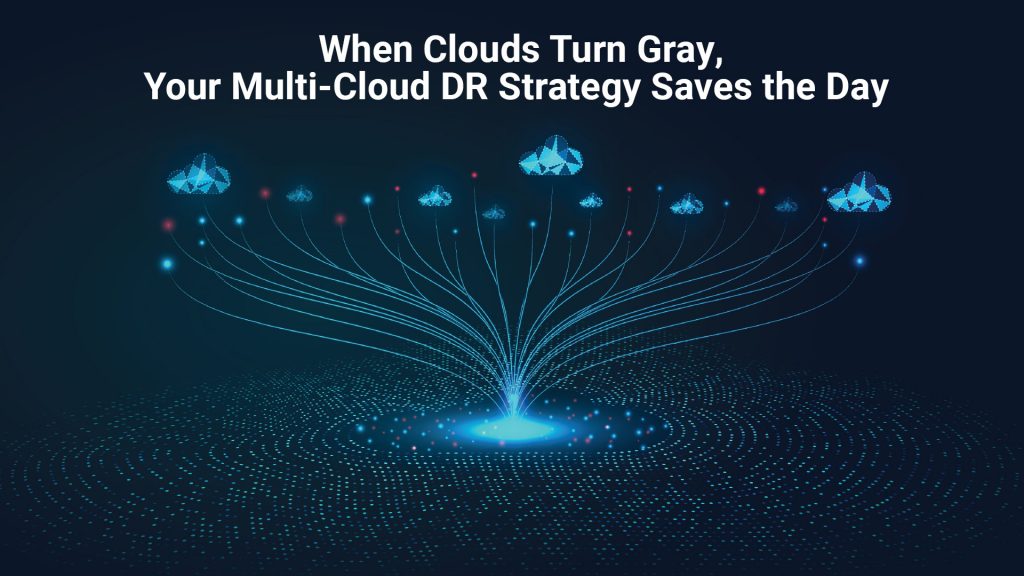Cloud apocalypse? Not on your watch. A multi-cloud strategy is your insurance policy against digital doomsday. When your business lives in the cloud, a single provider outage isn’t just an inconvenience—it’s a threat to your entire operation. Lost revenue, tarnished reputation, and even total shutdown are all on the line. But what if you could insulate your business from such a disaster? That’s where multi-cloud disaster recovery (DR) comes in.
This article explores the intricacies of multi-cloud DR, revealing how strategically distributing data and workloads across multiple cloud providers can provide unparalleled resilience and ensure business continuity, even in the face of the most unexpected events.
Understanding Multi-Cloud Disaster Recovery
Multi-cloud disaster recovery means safeguarding your backups and recovery systems using multiple cloud service providers. Instead of depending on one provider, you distribute these resources across different platforms. This creates a more robust disaster recovery infrastructure, taking advantage of each cloud provider’s specific strengths. If one provider experiences an outage or other issues, your data and operations remain protected and accessible, ensuring minimal downtime and data loss.
For example, let’s say a company, LutherCorp, stores its data and critical applications on AWS but wants to ensure business continuity, so it adopts a multi-cloud disaster recovery strategy. It backs up its data to Stage2Data’s private cloud and replicates its applications to Google Cloud Platform (GCP).
If there’s an AWS outage, LutherCorp can quickly failover to Stage2Data or GCP to access their data and resume operations with minimal disruption. This approach ensures that even if one cloud provider experiences issues, LutherCorp’s business can continue to run smoothly.
Let’s look at the benefits of having a multi-cloud disaster recovery strategy.
Benefits of Multi-Cloud Disaster Recovery
Enhanced Resilience
One of the main advantages of a multi-cloud DR strategy is increased resilience. By distributing data and recovery systems across multiple cloud providers, businesses can mitigate the risk of a single point of failure. If one cloud provider experiences an outage or data breach, the organization can quickly failover to another provider, ensuring continuous access to critical data and applications.
Improved Geographical Redundancy
A multi-cloud strategy also lets organizations easily store data in different geographical locations. This geographical redundancy is crucial for protection against regional disasters like natural calamities or widespread power outages. By using data centers in different regions or countries, businesses can ensure that their DR solution remains operational even if an entire area is affected.
Cost Optimization
While multi-cloud DR may seem more expensive at first glance, it can lead to cost savings in the long run. You can choose the most cost-effective services from each provider and then optimize your spending based on specific needs. Additionally, you can negotiate with multiple providers to get better pricing and terms.
Avoiding Vendor Lock-in
Relying on a single cloud provider for disaster recovery can lead to vendor lock-in. This makes it difficult and expensive to switch providers or bring workloads back on-premises if needed. A multi-cloud approach provides flexibility and reduces your reliance on a single vendor, so you can adapt your DR strategy according to your organization’s needs.
Compliance and Data Sovereignty
For businesses operating in regulated industries or across multiple jurisdictions, multi-cloud DR can help address compliance and data sovereignty requirements. Organizations can choose cloud providers and data center locations that align with specific regulatory needs, ensuring that data is stored and processed in compliance with local laws.
Challenges of Implementing Multi-Cloud Disaster Recovery
Increased Complexity
If you choose multi-cloud disaster recovery, be prepared to manage multiple providers, each with its own services and quirks. Your IT team will need to be well-versed in each platform and handle data replication and failover processes across different environments. This can lead to increased management overhead and the potential for misconfigurations if you're not careful.
Data Consistency and Synchronization
Ensuring data consistency across different cloud platforms can be challenging. You'll need to implement reliable data replication and synchronization mechanisms to keep all copies of your data up-to-date and consistent. This can be technically complex and may necessitate specialized tools or custom-built solutions.
Security and Compliance Management:
While multi-cloud disaster recovery can improve compliance, it also introduces new security concerns. You'll need to protect your data in transit and at rest across all providers, enforce consistent access controls, and maintain visibility into security events across your entire infrastructure. For this, you’ll need a comprehensive security strategy that spans all cloud environments.
Cost Management
Multi-cloud disaster recovery, while potentially cost-effective, requires careful financial oversight. You'll need to track and optimize spending across multiple providers, which can be intricate and time-consuming. Without proper management, costs can escalate, particularly if redundant or unused resources are not addressed.
Enhancing Resilience and Continuity
Despite these challenges, a well-implemented multi-cloud DR strategy can significantly enhance your organization’s resilience and continuity capabilities. Using multiple cloud providers, you can create a disaster recovery solution that minimizes data loss and downtime.
Think of it this way: if one cloud provider goes down, you’ve got other providers ready to pick up the slack, reducing the time it takes to get back up and running. And with strong data replication across clouds, you can potentially achieve near-zero data loss.
Multi-cloud disaster recovery solutions also offer substantial scalability and flexibility. Need more resources? No problem, just scale up. Need something specific for a certain workload? Use the unique capabilities of different cloud providers to fit your needs.
And perhaps best of all, a multi-cloud environment lets you thoroughly test your disaster recovery plans. You can regularly simulate failovers across different providers, spotting and fixing potential issues before they become real problems. This constant testing and improvement creates a super reliable and robust disaster recovery solution.
Ultimately, a multi-cloud disaster recovery approach gives you options—multiple pathways to recover and access your data. This flexibility lets you adapt to changing business needs or unexpected events, ensuring your operations and customer service levels stay high, even when things get tough.
Practical Tips for Implementing Multi-Cloud Disaster Recovery
For businesses considering a multi-cloud DR strategy, here are some practical tips to make sure you make the most out of it:
1. Conduct a Thorough Assessment
Start by taking a good look at what you need from your disaster recovery plan. This means figuring out how quickly you need to recover different applications and data (your RTO and RPO), what your most important workloads are, and which cloud providers would be the best fit for your needs.
2. Develop a Comprehensive Strategy
Think of this as your disaster recovery playbook. It should spell out how you’ll copy, store, and recover your data across different cloud providers. Don’t forget to include clear steps for switching over to your backup systems if something goes wrong and switching back when things are back to normal.
3. Choose Compatible Providers
The cloud providers you choose should offer services that work well together and have strong integration capabilities. Look for ones with disaster recovery features, like automatic failover (switching to backups) and reliable tools for copying data.
4. Implement Strong Data Management Practices
Make sure you have strong processes in place for managing your data so everything stays consistent across all the different cloud environments. This could involve automatically copying data, doing regular integrity checks, and keeping track of different versions of your data.
5. Prioritize Security and Compliance
Protecting your data is very important. Develop a security strategy that covers the challenges that come with using multiple clouds. This includes having consistent security policies in place across all the providers you use and using tools that give you a central view and control over everything.
6. Invest in Automation and Orchestration
Automating and orchestrating your disaster recovery processes can simplify your life. These tools can help reduce complexity, minimize the risk of human error, and make sure your DR processes run smoothly.
7. Consider Managed Services
If managing a multi-cloud disaster recovery solution yourself feels overwhelming, consider working with experts. A managed service provider like Stage2Data, which specializes in cloud solutions and DR as a managed service – DRaaS – can offer you the knowledge and resources to help you implement and maintain an effective DR strategy.
The Bottom Line
Using multiple clouds for disaster recovery is a smart way to protect your business when unexpected problems arise. By combining the strengths of different cloud providers, you can create a more reliable and flexible backup system for your data and operations, often at a lower cost.
It’s true that managing multiple cloud providers can be a bit more complex, and you might need some extra help to set things up correctly. But it’s definitely doable!
Start by understanding what your business really needs in disaster recovery. Then, create a detailed plan and invest in the right tools and support. When done well, this approach offers great protection against data loss and downtime, ensuring that you can keep serving your customers, no matter what happens.
Cloud technology is constantly changing, and using multiple clouds for disaster recovery is becoming a more common and important strategy for businesses of all sizes. By embracing this approach and tackling the challenges head-on, you can build a resilient IT infrastructure that can adapt and withstand any future disruptions.





